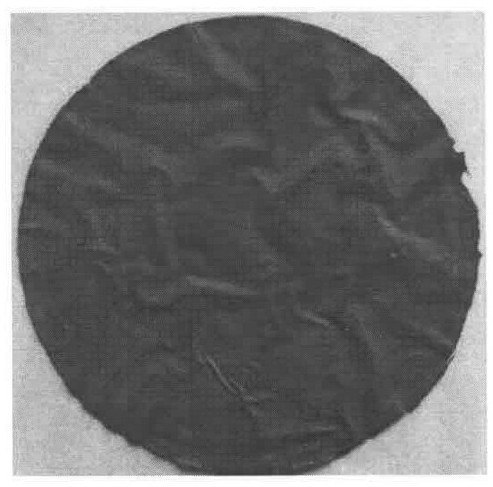A preparation method of titanium dioxide sheet/graphene composite film with {001} crystal plane
A graphene composite and titanium dioxide technology, which is applied in chemical instruments and methods, chemical/physical processes, light water/sewage treatment, etc., can solve problems that have not been reported, improve the transmission path, solve the problem of unrecyclable, and simple operation Effect
- Summary
- Abstract
- Description
- Claims
- Application Information
AI Technical Summary
Problems solved by technology
Method used
Image
Examples
Embodiment 1
[0020] a. Add 1mg of graphite oxide to 10mL of deionized water, sonicate for 0.5h to ensure that the graphite oxide is evenly dispersed, and then vacuum filter to obtain a graphite oxide film;
[0021] b. Add 0.1g of titanium tetrafluoride as a titanium source to 60mL of tetraethylene glycol solution, stir evenly at room temperature, add 0.1mL of glacial acetic acid, and react to obtain a clear solution without insoluble matter;
[0022] c. Then immerse the graphite oxide film obtained in step a into the clear solution obtained in step b, and then put it into the reaction kettle at a temperature of 80°C and keep it for 8h. After the reaction is completed, wash it alternately with deionized water and ethanol. Dry at a temperature of 60°C to obtain a titanium dioxide sheet / graphene composite thin film material with a {001} crystal plane.
Embodiment 2
[0024] a. Add 5 mg of graphite oxide to 10 mL of deionized water, ultrasonicate for 2 hours to ensure uniform dispersion of graphite oxide, and then vacuum filter to obtain graphite oxide film;
[0025] b. Add 0.5g of ammonium fluotitanate to 60mL of diethylene glycol solution, stir evenly at room temperature, add 0.5mL of glacial acetic acid, and react to obtain a clear solution without insoluble matter;
[0026] c. Then immerse the graphite oxide film obtained in step a into the clear solution obtained in step b, and then put it into the reaction kettle at a temperature of 120°C and keep it for 8h. After the reaction is completed, wash it alternately with deionized water and ethanol, Dry at a temperature of 60°C to obtain a titanium dioxide sheet / graphene composite thin film material with a {001} crystal plane.
Embodiment 3
[0028] a. Add 10 mg of graphite oxide to 10 mL of deionized water, ultrasonicate for 4 hours to ensure uniform dispersion of graphite oxide, and then vacuum filter to obtain graphite oxide film;
[0029] b. Add 1g of titanium tetrafluoride as a titanium source to 60mL of triethylene glycol solution, stir evenly at room temperature, add 3mL of glacial acetic acid, and react to obtain a clear solution without insoluble matter;
[0030] c. Then immerse the graphite oxide film obtained in step a into the clear solution obtained in step b, and then put it into the reaction kettle at a temperature of 160°C and keep it for 10h. After the reaction is completed, wash it alternately with deionized water and ethanol, Dry at a temperature of 60°C to obtain a titanium dioxide sheet / graphene composite thin film material with a {001} crystal plane.
PUM
 Login to View More
Login to View More Abstract
Description
Claims
Application Information
 Login to View More
Login to View More - R&D Engineer
- R&D Manager
- IP Professional
- Industry Leading Data Capabilities
- Powerful AI technology
- Patent DNA Extraction
Browse by: Latest US Patents, China's latest patents, Technical Efficacy Thesaurus, Application Domain, Technology Topic, Popular Technical Reports.
© 2024 PatSnap. All rights reserved.Legal|Privacy policy|Modern Slavery Act Transparency Statement|Sitemap|About US| Contact US: help@patsnap.com










